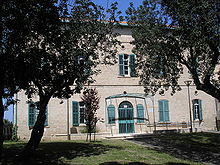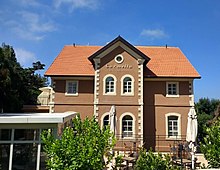Evangelical Carmel Mission
| Evangelical Carmel Mission | |
|---|---|
| legal form | registered association |
| founding | (1904) 1911 (as an association) |
| founder | Johannes Seitz |
| Seat | Schorndorf |
| motto | “The Carmel Call”: In the name of Jesus there is salvation! There is salvation in Him! Through Him alone! Jesus is the Redeemer! Jesus is god! Jesus is the Christ! |
| method | Tentmaker mission |
| Action space | arab and muslim countries |
| people | Friedrich Keller (first head of mission) |
| Employees | 30 in Germany, 200 abroad |
| Website | www.karmelmission.org |
The Evangelical Carmel Mission is a Christian mission founded in 1903/1904 that is active today among Arabs and Muslims. It began in the Carmel Mountains in Palestine. The administrative headquarters are in Schorndorf in Germany . It is based on the German Evangelical Alliance . Martin Landmesser is the CEO.
history
After the Evangelical Brothers' Union split off from the German Temple under Christoph Hoffmann at the end of the 19th century, the German Vice Consul Friedrich Keller , who was still a member of the Templars, asked the Brethren in 1879 on behalf of the German Templars who lived with him in and around Haifa to join the Brethren new covenant. In 1881 he sent the founding board member, the evangelist Martin Blaich , to Palestine to complete the admission. Once there, Blaich initiated the establishment of the mission station on Mount Carmel by collecting donations from the members of the German community in exile. In 1883, Keller bought the first property not far from Haifa on Mount Carmel.
When the first road was to be built, the "Lutheran heretics" from the nearby Catholic Carmelite monastery were stopped for the time being. Only after lengthy legal proceedings and the intervention of the German Chancellor Bismarck did the Pope order the road to be opened.
Bertha von Bannwarth, who had already financed the trials with the Carmelite monastery, also made a donation for the “Luftkurheim”, which was completed in 1887. When Friedrich Pross had his hotel built near him in 1893, competition threatened to undermine the funding of the mission station and Johannes Seitz , also a founding member of the Reichsbrüderbund, had to solve the problem. He asked the Saxon pastor Martin Schneider (1862–1933) to buy the Hotel Pross and manage the mission station. Feeling called by God, he bought the hotel in 1904 and moved in with his wife and children and his sister-in-law Frieda Schulze on May 29, 1904. The Carmel Mission was founded as a mission station for German settlers, Jews, Turks and Arabs on the Carmel .
Schneider started the mission among Jews because most of them spoke German. The mission among Arabs began later, because Schneider had to learn Arabic first. Schneider saw the mission among Jews not as a change of faith for them, but as a continuation of their faith. For this purpose kosher was cooked in his hotel. After Schneider sold the hotel in 1908, he and his family moved to what is now Beith Mainz (Sderot haNassi '103), before moving to what is now called Pastor-Schneider- Haus in Rechov haTischbi 130, which Gottlieb Mayer had built.
The Carmel Mission was supported in the following time by the “Dreierbund” from the Teichwolframsdorf home (Johannes Seitz), the Swiss Rämismühle and the Patros German tent mission home . On Ascension Day 1908, the principles of the Carmel Mission in Schorndorf, Württemberg, developed by Martin Schneider, were adopted and Johannes Seitz was appointed chairman, but it was not until November 1911 that the association based in Teichwolframsdorf was entered in the register. In 1923 the headquarters were relocated to Schorndorf.
During the First World War , Schneider had to leave the Turkish-occupied “Palestine” and was only allowed to re-enter in 1920.
From 1913 to 1952 Wilhelm Sziel was mission leader. In 1952 Erich Schmidinghoff, former federal manager of the German Association of EC Youth Associations , became the new head of mission.
When the Second World War broke out , the home on the mountain was closed, the younger employees were sent to Germany and the older employees were interned in Waldheim near Haifa . Only Hugo Löwenstein continued the mission to the Jews until he died in 1944.
The houses of the original seat on Mount Carmel were expropriated at the time of the establishment of the State of Israel. The mission from Haifa and Mount Carmel with the goal of “Witness service in the Holy Land and the Middle East” ended between 1948 and 1956. The area of activity now expanded to include all Arab and Muslim countries.
Principles
The Carmel Mission has five principles: First, it sees Jesus Christ as its head and base. Second, the Bible is a guide for teaching and life. Thirdly, it wants to awaken life, build up Christians and pursue missions. Fourth, a group of helpers should send trained, “truly converted” workers to the mission. Finally, the Carmel Mission sees its financing only dependent on Jesus Christ and therefore does not pay a salary, but relies on God to provide for its employees.
literature
- Rolf Scheffbuch : “Karmel” trademark. One hundred years of Evangelical Carmel Mission. Johannes-Seitz-Verlag, Stuttgart 2003
- Evangelical Carmel Mission, Schorndorf: 100 Years of the Carmel Mission: 1904–2004. Carmel Mission, 2003
- Walter Wassermann: The Origin of the Evangelical Carmel Mission (1881-1911). Evangelical Carmel Mission, 1994
- Wilhelm Sziel: History of the development of the Evangelical Carmel Mission e. V .: According to reports from Johannes Seitz. Evangelical Carmel Mission, 1954
Web links
Individual evidence
- ↑ a b Rolf Scheffbuch: Trademark "Karmel". One hundred years of Evangelical Carmel Mission. Johannes-Seitz-Verlag, Stuttgart 2003, p. 5.
- ^ Rolf Scheffbuch: Trademark "Karmel". One hundred years of Evangelical Carmel Mission. Johannes-Seitz-Verlag, Stuttgart 2003, p. 61.
- ↑ Evangelische Carmel Mission (KM): Membership information, waw-online.de, accessed on July 1, 2017.
- ↑ Horst Robert Balz; Gerhard Krause; Gerhard Müller: Evangelical Alliance. In: Theologische Realenzyklopädie , Volume 10, p. 653.
- ↑ https://karmelmission.org/new-page-2
- ^ Rolf Scheffbuch: Trademark "Karmel". One hundred years of Evangelical Carmel Mission. Johannes-Seitz-Verlag, Stuttgart 2003, p. 6.
- ↑ a b Rolf Scheffbuch: Trademark "Karmel". One hundred years of Evangelical Carmel Mission. Johannes-Seitz-Verlag, Stuttgart 2003, p. 7.
- ↑ Martin Schneider acquired the building in 1904, but sold it to the Anglican missionary Francis Newton in 1908. James de Rothschild then acquired the building in 1948 for the administration of PICA , before the city acquired it in 1959, which it named Beith Rothschild after him and established it as a cultural and meeting center. There was no budget to maintain the building, so that at the end of the 1990s the city sold the building to the Edith and Re'uven Hecht Foundation, which renovated the building and reopened it in 2002 as a cultural center called Beith Hecht .
- ^ Haifa's twin city Mainz donated the 'Sifriath Mainz / Magenza סִפְרִיַּת מײַנְץ (מַגֶנְצַא)'(Mainz / Magenza library), the name of which was transferred to the house, and renewed the library after a fire in January 2016. Cf. Bernd Funke, "Sister city Haifa: Two important buildings connected to Mainz were destroyed by fire" , in: Allgemeine Zeitung , June 3, 2017, accessed on January 19, 2019.
- ^ Rolf Scheffbuch: Trademark "Karmel". One hundred years of Evangelical Carmel Mission. Johannes-Seitz-Verlag, Stuttgart 2003, p. 9.
- ^ Rolf Scheffbuch: Trademark "Karmel". One hundred years of Evangelical Carmel Mission. Johannes-Seitz-Verlag, Stuttgart 2003, p. 10.
- ↑ a b Rolf Scheffbuch: Trademark "Karmel". One hundred years of Evangelical Carmel Mission. Johannes-Seitz-Verlag, Stuttgart 2003, p. 4.
- ↑ a b Rolf Scheffbuch: Trademark "Karmel". One hundred years of Evangelical Carmel Mission. Johannes-Seitz-Verlag, Stuttgart 2003, p. 11.
- ^ Rolf Scheffbuch: Trademark "Karmel". One hundred years of Evangelical Carmel Mission. Johannes-Seitz-Verlag, Stuttgart 2003, p. 14.
- ^ Rolf Scheffbuch: Trademark "Karmel". One hundred years of Evangelical Carmel Mission. Johannes-Seitz-Verlag, Stuttgart 2003, p. 15.
- ^ Rolf Scheffbuch: Trademark "Karmel". One hundred years of Evangelical Carmel Mission. Johannes-Seitz-Verlag, Stuttgart 2003, p. 17.
- ↑ a b Rolf Scheffbuch: Trademark "Karmel". One hundred years of Evangelical Carmel Mission. Johannes-Seitz-Verlag, Stuttgart 2003, p. 16.
- ^ Rolf Scheffbuch: Trademark "Karmel". One hundred years of Evangelical Carmel Mission. Johannes-Seitz-Verlag, Stuttgart 2003, p. 24.
- ^ Rolf Scheffbuch: Trademark "Karmel". One hundred years of Evangelical Carmel Mission. Johannes-Seitz-Verlag, Stuttgart 2003, p. 25.
- ^ Rolf Scheffbuch: Trademark "Karmel". One hundred years of Evangelical Carmel Mission. Johannes-Seitz-Verlag, Stuttgart 2003, p. 29.
- ^ Rolf Scheffbuch: Trademark "Karmel". One hundred years of Evangelical Carmel Mission. Johannes-Seitz-Verlag, Stuttgart 2003, p. 19.


